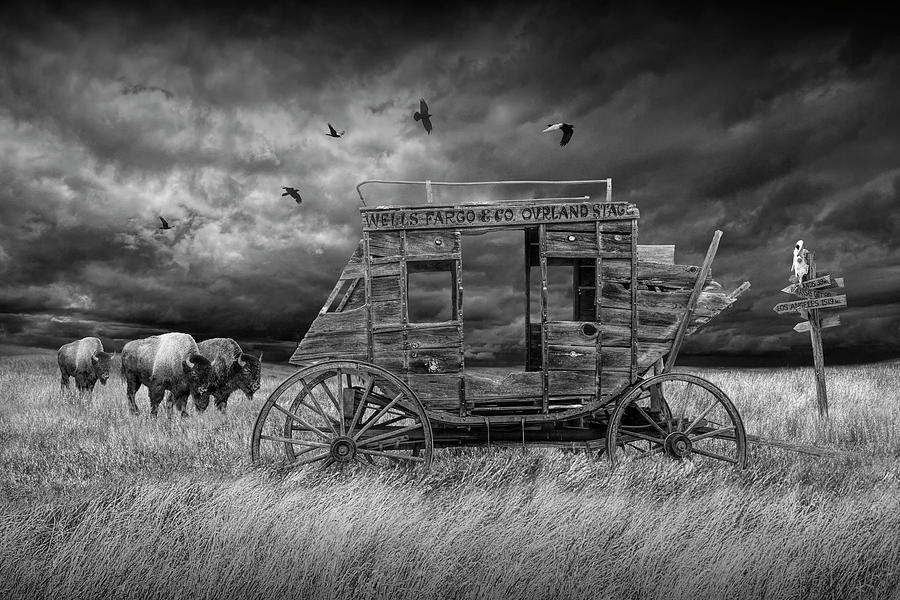
Wachovia Meltdown
How did Wells Fargo takeover Wachovia? Contributor BRENDA WENSIL had a front row seat during the 2008 Financial Crisis, and says it happened somewhere on the Road to Abilene.

An abandoned Wells Fargo Stagecoach via Randall Nyhof
Monday, September 29, 2008 began like most mornings in many ways. But as I stepped from the shower listening to morning news in the background, the words not only promised to change the day, but also the course of my future and that of many others in the financial services industry and beyond.
The announcement that Wachovia Corporation had been acquired by Citi Bank overcast an otherwise beautiful fall morning. That news was topped only four days later when Wells Fargo trumped Citi's deal in a last minute change of events in an already historic week of financial news.
In my 18 years with First Union, and later Wachovia, we had always turned up on the winning side of the acquisition equation. As I started with the company in 1990, the loopholes in interstate banking had only recently been discovered, sparking the wave of banking buyouts that turned into an acquisition avalanche in the following decade. Through the years, I was an active participant as our bank aggressively mounted wins with confidence then arrogance that bordered on hubris.
This time we had lost the duel.
As I walked through the rest of that day and the weeks and months that followed it was clear just how severe the loss was for all of us. The glory days of my company, the financial industry and the markets as a whole were forever changed. What wasn't as clear to me then is how I would recover from a lunge that pierced so deeply. Of course, the disaster impacted my retirement timeline, like so many others. But more than that, it forever changed the way I will work, the loyalties I will allow and the warning signs of organization dysfunction that can lead to such catastrophe.
Reflecting now, nearly two years later, I recognize that like so many colleagues, I absorbed personal impacts of wreckage that might have been avoided in a thousand different ways. But these days I have less consternation for those who made bad decisions and more curiosity about just how an organization’s culture can make the passage of those decisions possible.
From my line of sight, it seemed that many subtle changes might have come together with a thousand other interconnected factors to cause such a cataclysmic disaster. My observations are these: A culture out of touch with history can lose an edge in forecasting future events. An organization that built its success largely on collaboration and inclusion gradually narrowed its range of decision makers, making it fragile in withstanding external pressures. And, for a complex company in such a significant industry as financial services to survive, there must be an environment that invites differing points of view, and dissension as well as healthy conflict.
“The only thing new to us is the history we don't know;” a phrase that haunted me during the year preceding the market failures. A storm had been brewing in the external markets for awhile. A softening housing market cast dark clouds across the country. Speculators and investors refused to move in from the coming rain and instead chose to ride out the market trend that promised a never ending rate of return. But previous crashes have all been preceded by an extraneous shock of some sort, breaking the herd psychology that makes markets run high. History must have been destined to repeat itself.
Why History Matters
In 1893, the crash was foreshadowed by the bankruptcy of the National Cordage Company. In 1907, it was the collapse of the Knickerbocker Trust Company. The crash of October 1929 was by one count the 11th panic to grip the stock market since Black Friday of 1869. Stock market crashes during the 19th and early 20th centuries had invariably been associated with banking crises. The market and the banking systems have always been too interconnected not to impact each other.
In March 2008, the United States had five great investment banks. Six months later, there were none. In March of that same year, Bear Stearns collapsed. In September Lehman Brothers failed, and Bank of America saved Merrill Lynch. One week later, savings thrift Washington Mutual under FDIC pressure was rescued by a JP Morgan buyout. That's when our own reality came crashing in at Wachovia. Swords were drawn when Wachovia announced the acquisition of Golden West in 2006, for a premium of $24 billion. Analysts lunged with doubts and direct questions about Wachovia's management and decision making. Wachovia countered with defensive reasoning that it was "a sound decision at exactly the wrong time." As history will have it, we had purchased a West coast sub-prime lender at the height of the market; a move reminiscent of our acquisition a decade earlier of another company-crashing sub-prime lender on the West Coast called The Money Store.
I am no historian. And, I am surely no financial market analyst. But looking back I can’t help but wonder what might have happened had we given more credence to time honored trends that could have suggested other courses of action. Housing markets cave. Financial instruments falter. Decisions gone wrong are defended too long and past the point of belief. This was a systemic crisis. It was an old movie. And every generation that endures it, dare I say repeats it, labels it the greatest economic catastrophe of all time. Perhaps we forgot history. Or perhaps we chose to believe that the principles of human nature and market volatility throughout time simply did not apply to us. Either way, we lost.
But it wasn't the storm outside that should have been the harbinger of things to come. Inside Wachovia, a different storm had been brewing long before softening markets and failing investment firms. It seems to me now that we were beginning to abandon the very strengths that brought us to the dance in the first place; our ability to collaborate and work together for the greater good, to focus on customer needs and service delivery.
For so long, the company had built a franchise through solid competition and hard work. Business units leveraged each other during market swings. Leadership and teams focused on franchise expansion, and galvanized efforts to reclaim our customer service reputation. Many of these efforts I had the opportunity to actively lead or be a part of building. I enjoyed first hand our ability to reach across geographies and areas of expertise to make things possible.
But over time, something happened that began to turn healthy internal cooperation into selfish, more sinister efforts to grab power. At times it felt like we were more caught up in competing with ourselves than with rivals in the marketplace. Situations often pitted executive against executive causing each of their respective teams to execute directives regardless of the impact to other areas.
Some leaders worried about their legacies, or succession plans. More unfortunate were many leaders who had been loyal to the company and to certain executives for so long who found themselves suddenly sidelined, without warning or explanation. The sense that one day you’re in and the next day you could be out breeds a cautious, fear-filled environment, which was so far from the company I had grown to know.
Simply put, our great strength of inclusion and partnership began to shift so subtly that I’m not sure we could see it at the time. While none of that is the single reason for our ultimate demise, the winner-takes-all atmosphere started to undermine the team-over-self spirit that had once galvanized the company.
When people stop working together, for whatever reason, very little good can come as a result.
But perhaps the biggest tragedy as I look back is one of failing to be painfully truthful at the most critical junctures. Perhaps it was our polite culture that made it difficult to challenge decisions like Golden West, or made it the norm to agree while together and disagree in silence when apart. Perhaps our incentive structures or unwritten rules of conduct made it unpopular to offer a dissenting view. Perhaps all of us were guilty of this at times. Perhaps all of us were afraid of something. I don’t know. But it began to force the decision-making process down an unchallenged path with fewer and fewer travelers.
I could not help but think of "The Road to Abilene," the now famous story about group-think by management expert Dr. Jerry Harvey. The Abilene Paradox is a story in which a group of people collectively decide on a course of action that is counter to the preferences of any of the individuals in the group. It highlights the desire to not rock the boat.
Ironically, this story had been used in First Union management meetings during Ed Crutchfield’s years to promote honest group communications. And now, here it was reminding me that the dynamics of this simple and compelling story were potential causes for our tragic ending.
As the story goes, a family of four agrees to jump in the car on a hot Texas day for an outing. While everyone politely agreed to go along, no one actually wanted to go at all. By accommodating each other, they each became complicit in a total waste of time, making a 106-mile round trip in the desert, under intense summer heat on a trip nobody had been looking forward to and nobody wanted to make.
In the end, while everyone needs to blame someone for everything, clearly Ken Thompson was not the only one responsible for decisions that put us on the tip end of the sword. The operating committee went along. The board of directors went along. We all went along. But while we all went down the road together, after the fact, it has been hard to find anyone who actually thought it was a good idea.
Our story, once remarkably brilliant, ended in disgrace. When the culture does not allow people to hear varying points of view or to tell painful truths, nothing good can happen.
History matters. Working together nets a better outcome. The truth must be told. After all this time, these lessons of our fall will remain. Much like Ernest Hemingway’s “movable feast” no matter where I go for the rest of my life, they will go with me.
Economic Crash & Recovery
So, there I was stepping out of the shower on a day that changed my future. Misfortune had lunged my way, and in that moment I had no idea what my recovery would look like. I had enjoyed a wonderful career, a terrific ride with brilliant and outstanding people, and I took from that a rich experience. But as truth would have it, the disaster of this duel had actually liberated me, and after 20 years with the company I found freedom in letting go. I completed a year transitioning work to Wells Fargo and then made an exit stage left.
I recovered with new and energizing work inside and outside the country, both in and out of the financial industry.
I recovered through a renewed and healthy forgiveness for the trials of our past.
I am no longer dazed by the company’s collapse or the market’s woes.
I find no gratification in the occasional sighting of our once winning CEO flying commercial airlines.
I will not get in the car to Abilene.
I will not leave those who have shown me loyalty to wonder what’s happening around them or to them.
I will not presume or defer ever again to the notion that any executive leadership team or board of directors is the smartest bunch in the room.
And I will forever believe that the only thing constant through our times is the force of human behavior that will repeat itself from age to age.
Recovery complete.






